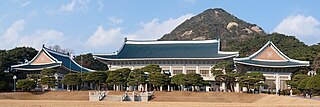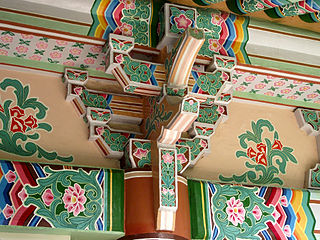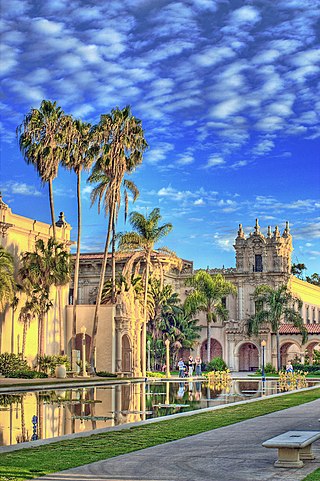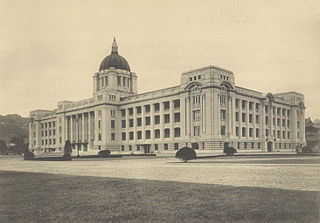Related Research Articles

The Centennial International Exhibition,officially the International Exhibition of Arts,Manufactures,and Products of the Soil and Mine,was held in Philadelphia from May 10 to November 10,1876. It was the first official world's fair to be held in the United States,and coincided with the centennial anniversary of the Declaration of Independence's adoption in Philadelphia on July 4,1776.

The International Style or internationalism is a major architectural style that was developed in the 1920s and 1930s and was closely related to modernism and modernist architecture. It was first defined by Museum of Modern Art curators Henry-Russell Hitchcock and Philip Johnson in 1932,based on works of architecture from the 1920s. The terms rationalist architecture and modern movement are often used interchangeably with International Style,although the former is mostly used in the English-speaking world to specifically refer to the Italian rationalism,or even the International Style that developed in Europe as a whole.

Gyeongbokgung,also known as Gyeongbokgung Palace,was the main royal palace of the Joseon dynasty. Built in 1395,it is located in northern Seoul,South Korea. The largest of the Five Grand Palaces built by the Joseon dynasty,Gyeongbokgung served as the home of the royal family and the seat of government.

Changdeokgung,also known as Changdeokgung Palace or Changdeok Palace,is set within a large park in Jongno District,Seoul,South Korea. It is one of the "Five Grand Palaces" built by the kings of the Joseon dynasty (1392–1897). As it is located east of Gyeongbok Palace,Changdeokgung—along with Changgyeonggung—is also referred to as the "East Palace".

Cheong Wa Dae,also known as the Blue House in English,is a public park that formerly served as the presidential residence and the diplomatic reception halls of South Korea from 1948 to 2022. It is located in the Jongno district of the South Korean capital Seoul.

The Carnegie Museum of Art is an art museum in the Oakland neighborhood of Pittsburgh,Pennsylvania. The museum was originally known as the Department of Fine Arts,Carnegie Institute and was formerly located at what is now the Main Branch of the Carnegie Library of Pittsburgh. The museum's first gallery was opened for public use on November 5,1895. Over the years,the gallery vastly increased in size,with a new building on Forbes Avenue built in 1907. In 1963,the name was officially changed to Museum of Art,Carnegie Institute. The size of the gallery has tripled over time,and it was officially renamed in 1986 to "Carnegie Museum of Art" to indicate it clearly as one of the four Carnegie Museums.

Korean architecture refers to an architectural style that developed over centuries in Korea. Throughout the history of Korea,various kingdoms and royal dynasties have developed a unique style of architecture with influences from Buddhism and Korean Confucianism.

The Tokyo National Museum or TNM is an art museum in Ueno Park in the Taitōward of Tokyo,Japan. It is one of the four museums operated by the National Institutes for Cultural Heritage,is considered the oldest national museum in Japan,is the largest art museum in Japan,and is one of the largest art museums in the world. The museum collects,preserves,and displays a comprehensive collection of artwork and cultural objects from Asia,with a focus on ancient and medieval Japanese art and Asian art along the Silk Road. There is also a large collection of Greco-Buddhist art. As of April 2023,the museum held approximately 120,000 Cultural Properties,including 89 National Treasures,319 Horyuji Treasures,and 649 Important Cultural Properties. As of the same date,the Japanese government had designated 902 works of art and crafts as National Treasures and 10,820 works of art and crafts as Important Cultural Properties,so the museum holds about 10% of the works of art and crafts designated as National Treasures and 6% of those designated as Important Cultural Properties. The museum also holds 2,651 cultural properties deposited by individuals and organisations,of which 54 are National Treasures and 262 are Important Cultural Properties. Of these,3,000 cultural properties are on display at one time,with each changing for between four and eight weeks. The museum also conducts research and organizes educational events related to its collection.

The International Exhibition of Modern Decorative and Industrial Arts was a specialized exhibition held in Paris,France,from April to October 1925. It was designed by the French government to highlight the new modern style of architecture,interior decoration,furniture,glass,jewelry and other decorative arts in Europe and throughout the world. Many ideas of the international avant-garde in the fields of architecture and applied arts were presented for the first time at the exposition. The event took place between the esplanade of Les Invalides and the entrances of the Grand Palais and Petit Palais,and on both banks of the Seine. There were 15,000 exhibitors from twenty different countries,and it was visited by sixteen million people during its seven-month run. The modern style presented at the exposition later became known as "Art Deco",after the exposition's name.

The California Pacific International Exposition was an exposition held in San Diego,California during May 29,1935–November 11,1935 and February 12,1936–September 9,1936. The exposition was held in Balboa Park,San Diego's large central urban park,which had also been the site of the earlier Panama-California Exposition in 1915.

National Folk Museum of Korea (Korean: 국립민속박물관) is a national museum located on the grounds of Gyeongbokgung Palace in Jongno-gu,Seoul,South Korea. It uses replicas of historical objects to illustrate the history of traditional life of the Korean people.

The Japanese General Government Building,also known as the Government-General Building and the Seoul Capitol,was a building located in Jongno District of Seoul,South Korea,from 1926 to 1996.

Pointe-à-Callière Museum is a museum of archaeology and history in Old Montreal,Quebec,Canada. It was founded in 1992 as part of celebrations to mark Montreal's 350th birthday. The museum has collections of artifacts from the First Nations of the Montreal region that illustrate how various cultures coexisted and interacted,and how the French and British empires influenced the history of this territory over the years. The site of Pointe-à-Callière has been included in Montreal’s Birthplace National Historic Site since its designation in 1924.

The National Palace Museum of Korea is a national museum of South Korea located in Gyeongbokgung Palace,Seoul.
The following is a timeline of the history of the city of Seoul,South Korea.

The National Museum of Contemporary Art,Korea (MMCA) is a contemporary art museum with four branches in Gwacheon,Deoksugung,Seoul and Cheongju. The museum was first established in 1969 as the only national art museum in the country accommodating modern and contemporary art of Korea and international art of different time periods.
Kim Kulim is a South Korean artist. Primarily self-taught,Kim Kulim's artistic practice has been shaped by his involvement in Seoul's experimental art scene in the late 1960s and early 1970s,his exposure to Japan's art scene in the mid-1970s,and his decades in the United States. Never limiting himself to abiding by artistic conventions,Kim has repeatedly transgressed boundaries,in ways that the art critic Oh Kwang-su has described as extending an experimental spirit into his present-day artistic practice.

The Tokyo Industrial Exhibition was held in Tokyo,Japan in 1907. Held in Ueno Park,the event celebrated Imperial Japan's economic prowess and patriotism. The event succeeded the five prior National Industrial Exhibitions,but was not organized by the central government. A sixth industrial exhibition had been postponed due to the Russo-Japanese War.

The Government-General Museum of Chōsen was a museum in Seoul during the period of Japanese rule. Built in the grounds of Gyeongbokgung Palace for the 1915 Chōsen Industrial Exhibition,the museum opened on 1 December 1915. The museum did not operate as an independent agency,and the department under which it fell was subject to bureaucratic reorganization. The museum was disestablished in 1945 and its collections transferred to the National Museum of Korea,which opened on 3 December 1945. In 1998,the museum building was demolished,after it had come to be viewed as a "symbol of colonialism".
References
- 1 2 Pérez-Gómez, Alberto; Parcell, Stephen (February 2016). Chora 7: Intervals in the Philosophy of Architecture. McGill-Queen's Press - MQUP. ISBN 9780773598799 . Retrieved 12 December 2017.
- 1 2 Jung, Yoonchun (November 2014). Inventing the identity of modern Korean architecture, 1904-1929 (Thesis). McGill University, Montreal, Canada.
- 1 2 3 4 Kal, Hong (2011). Aesthetic Constructions of Korean Nationalism: Spectacle, Politics and History. ISBN 9780415602563.